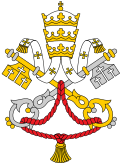当选教宗斯德望
此条目需要补充更多来源。 (2019年10月3日) |
| 当选教宗 斯德望 Electus Stephanus PP. | |
|---|---|
 | |
| 就任 | 752年3月23日 |
| 卸任 | 752年3月26日 |
| 前任 | 圣匝加利亚 |
| 继任 | 斯德望二世 |
| 个人资料 | |
| 本名 | 斯德望 |
| 逝世 | 752年3月26日 罗马 |
教宗当选者斯德望(拉丁语:Electus Stephanus PP.;?—752年3月25日)本名不详,是752年3月23日当选教宗的罗马神父,为圣匝加利亚的继位者。其在位三天(或四天)后中风猝逝,成为历任教宗在位最短者[1][2],因生前未及接受主教祝圣仪式,许多天主教历史书籍因而不视他为教宗,称下任同名教宗为斯德望二世。
745年,圣匝加利亚提拔他为圣基所恭圣殿领衔堂区的枢机,该堂区后由枢机弗雷德里克(英语:Cardinal Frederick of Lorraine)接任,后者后来成为教宗斯德望九世。
《宗座年鉴》中提到其“继任者”斯德望二世(三世)时,注释道:“圣匝加利亚死时,罗马神父斯德望被选为新教宗,但由于他隔四天后便死亡,未及参加他的主教祝圣仪式,根据《天主教法典》此时其任职才真正生效,因此其姓名没有登记在宗座书籍上,亦不见于其他教宗列表。”[3]
752年到942年,共有八位名为斯德望的教宗(包括本条目者),但仅七位有实际统治。十世纪前教宗无统治序数,彼时附于名后的编号皆属追认。当在名后附加编号成为惯例后,首位自号为斯德望者为斯德望九世,他一生均以“教宗斯德望九世(Stephanus Papa Nonus)”署明文件。
直到1975年10月1日的教会法[4]都还视当选当下即为就任,因此本条目之斯德望在1961年被自《宗座年鉴》移除前,曾被编序为二世,有些作者从而把其后所有同名教宗编号增加一位,由斯德望二至九世被序称为三至十世[5],这种编号的分歧见于《天主教百科全书》[6]、《宗座年鉴》[3]以及《大英百科全书》[7]。在1996年2月22日,教宗若望保禄二世颁布的宪令(第89款)规定:“若当选者尚非主教...只有在其被祝圣为主教后,才得宣布其当选”,方解决此类纷争。
参见
[编辑]参考资料
[编辑]- ^ Horace Mann, "Pope Stephen II" in Catholic Encyclopedia (New York 2013). [2015-09-01]. (原始内容存档于2012-06-22).
- ^ History's great untold stories: larger than life characters & dramatic ... (页面存档备份,存于互联网档案馆) By Joseph Cummins. National Geographic Books. p. 13.
- ^ 3.0 3.1 Annuario Pontificio 2012 (Libreria Editrice Vaticana 2012 ISBN 978-88-209-8722-0), p. 11*
- ^ On that date, Pope Paul VI changed the law, laying down in his apostolic constitution Romano Pontifici eligendo (页面存档备份,存于互联网档案馆) that (to quote an English version of the document (页面存档备份,存于互联网档案馆)), "88. After his acceptance, the person elected, if he be a bishop, is straightway bishop of Rome, true pope, and head of the episcopal college. He possesses and can exercise full and supreme power over the universal Church. If, however, the elected person does not possess the episcopal character, he is to be immediately ordained a bishop." Pope Paul VI's change of the law was incorporated into the 1983 Code of Canon Law (页面存档备份,存于互联网档案馆): "Can. 332 §1 The Roman Pontiff acquires full and supreme power in the Church when, together with episcopal consecration, he has been lawfully elected and has accepted the election. Accordingly, if he already has the episcopal character, he receives this power from the moment he accepts election to the supreme pontificate. If he does not have the episcopal character, he is immediately to be ordained Bishop."
- ^ Richard P. McBrien, Lives of the Popes (Harper Collins 2013 ISBN 978-0-06228834-9), p. 121. [2015-09-01]. (原始内容存档于2016-09-22).
- ^ For instance, Pope Stephen II (III) (页面存档备份,存于互联网档案馆)
- ^ Encyclopaedia Britannica, 14 pages in volume 17. [2015-09-01]. (原始内容存档于2016-03-22).

